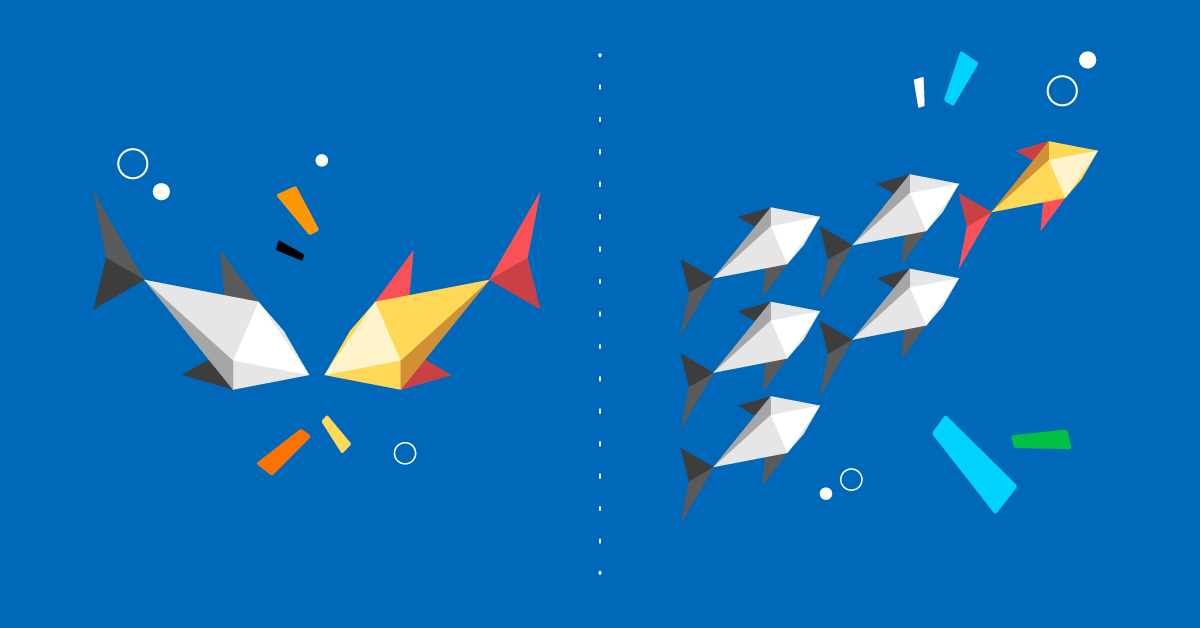In the heart of Salesville, Alex and Lilly were top salespeople known for their legendary competition. A sales contest with a vacation prize ignited their rivalry.
Neck and neck on the leaderboard, their approaches catered to different customer preferences. Alex mastered product details to deliver convincing pitches. Lilly used emotional intelligence to build a friendly rapport with customers.
Alex won by a slim margin, celebrating with pride. Yet, Lilly’s congratulatory handshake surprised Alex. Their rivalry somehow transformed into mutual respect.
The realization?
Rivalry motivated them. But it wasn’t everything.
There were strengths in each other’s strategies. And to keep improving performance, they needed to learn from each other too. Which meant balancing competition with collaboration.
In the world of sales, two distinct forces shape success: collaboration vs competition. Sales teams are known for embodying these dynamics while they navigate the market.

Collaboration vs competition
Competition fuels individuals to outshine, to be the top performer. It sharpens skills, accelerates innovation, and drives results. It’s the friendly rivalry that compels salespeople to surpass targets, striving for personal victories.
On the other hand, collaboration goes beyond individual achievements. It’s all about pooling talents, insights, and ideas. Collaborative sales teams emphasize teamwork, as members combine strengths to achieve collective goals. Information flows freely, fostering a sense of unity and shared accomplishments.
In the sales arena, these forces coexist, each offering unique benefits.
For example, enhanced communication and collaboration using social technologies might result in a 20 to 25% increase in the productivity of interaction workers (doctors, lawyers, sales representatives, etc.)
Striking the right balance between these two dynamics is key–harnessing the power of competition without undermining the spirit of collaboration paves the way for a successful sales journey.
The pitfall of overcompetitiveness: Navigating the risky side of overdrive
In sales, competition is often used to boost team performance. But this strategy can have an unintended (and unwanted) consequence. Let’s dig deeper.
Imagine a sales manager introducing a scoring system to reward top sales performers. Their goal is to drive individuals toward their fullest potential. But what impact does this have on the team? Immersed in a culture of intense competition, the focus of team members shifts. Driven by a desire to win, instead of sharing insights, they hoard their own knowledge and skills.
This guarded approach acts as a barrier to collaboration and collective growth. To mitigate this, it’s crucial to strike a balance between collaboration vs competition by:
- Encouraging transparent communication
- Fostering a culture of knowledge sharing and support
- Recognizing the benefits of collaboration
Last but not least, it’s essential that sales enablement practices should expand beyond individual metrics to encompass team contributions.
Meet TalentLibrary™
A growing collection of ready-made courses that cover the soft skills
your teams need for success at work
![]()

Fueled by ambition: The power of healthy competition
That said, healthy competition underpins successful sales teams. It inspires individuals to elevate their performance by pushing their limits. It fosters creative thinking and innovative problem-solving. It boosts motivation and delivers a sense of achievement. And it cultivates a culture of continuous improvement.
The key is to keep it healthy. But how? Here are three examples of healthy competition tactics:
- Sales leaderboards: Displaying top performers on a leaderboard stimulates friendly competition. Sales employees strive to reach the top spot by using unique strategies. This boosts motivation and encourages individuals to think outside the box.
- Team challenges: Competing in teams for shared goals fosters collaboration and competition. It gives reps the opportunity to exchange ideas. And explore different solutions and approaches. About to penetrate a new market? Give teams the task of brainstorming new strategies.
- Innovation pitch competition: Pitching new ideas in a competitive way, forces sales reps to think more creatively. As a result, they discover new approaches that can even reshape the whole sales process.
Striking the right balance between collaboration vs competition
Working together, collaboration and competition can make sales teams and reps more successful. But to create a positive and productive environment, there needs to be a happy medium between the two.
So, how can sales managers customize the collaboration vs competition dynamic so it strikes the right balance?
- Rotating pairs: Promote cross-collaboration by switching salespeople around so they spend time with different partners. This allows team members to share knowledge and learn from each other’s strengths and styles. While still maintaining a competitive spirit.
- Shared goals: Set common objectives that everyone in the sales team works towards. By focusing on common goals, organizations can emphasize collective success rather than individual triumphs.
- Group training: To boost collaboration, plan regular team training sessions. Blend sales-specific training with opportunities to build soft skills. And use discussion boards so teams can exchange ideas and experiences after training has finished.
Ready to transform your sales team’s learning experience?
Empower your employees with group training using TalentLMS.
The training platform that users consistently rank #1.
- Recognition schemes: Celebrate and appreciate not only top performers but also those who demonstrate significant improvement. This fosters a growth mindset and encourages individuals to collaborate to improve their skills.
- Collaborative competitions: Contests where salespeople compete in pairs or teams to achieve certain objectives can go a long way. Team members are encouraged to leverage each other’s strengths while simultaneously striving for success.
- Collaborative incentives: Tie rewards to team achievements instead of focusing on individual results. This way, organizations promote the importance of collective effort and success as people work together to achieve shared milestones.
- Cross-department collaboration: Boost collaboration with other departments (for example, marketing or customer service) to enhance the employee experience. Team efforts inspire creative problem-solving and innovation. In fact, collaboration between sales and marketing, according to 87% of sales and marketing leaders, drives crucial business growth.
- Sharing feedback: Peer-to-peer feedback cultivates a culture of continuous learning and improvement. But for it to be successful, it needs to be constructive and supportive.
- Team building activities: Team building events or workshops that focus on improving communication and teamwork, help strengthen salespeople relationships and boost collaborative efforts.
Forging futures together: The power of sharing values and goals
Striving towards shared values and goals in sales is not just a strategic choice, but the cornerstone of a bonded, high-performing team.
When salespeople work towards a common purpose, their individual efforts harmoniously synchronize into a force that brings successful results. Shared values aren’t only a moral compass that guides decisions towards cohesion. They channel collective energy, encouraging each member to give their absolute best.
This collaboration transforms competition into camaraderie and nurtures a culture of innovation and creative problem-solving. After all, in sales, the team’s strength doesn’t only lie in their products or services, but also in the shared values and goals that shape its mission.
So, don’t focus on just closing deals; cultivate a work environment where unity propels success and lasting impacts.



